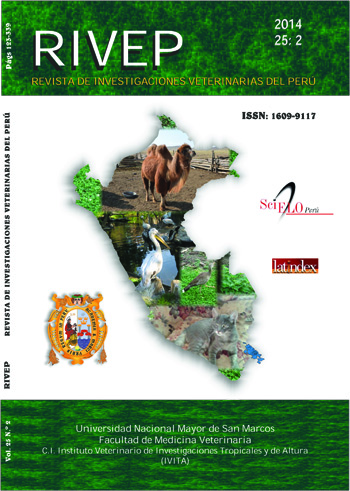LECTINHISTOCHEMISTRY STUDY OF THE UTERUS OF ALPACAS (Vicugna pacos)UNDER SUPEROVULATION TREATMENT
DOI:
https://doi.org/10.15381/rivep.v25i1.8463Keywords:
alpaca, lectins, glycosylation pattern, endometrium, superovulationAbstract
The aim of this study was to determine the glycosylation pattern in the uterine endometrium of alpacas with and without superovulation treatment. Uterine tissues were obtained from five non-treated alpacas with ovarian follicles less than 4 mm and five superovulated alpacas where FSH, GnRH and hCG was used. Samples from theuterus and uterine horns were analyzed by histochemistry (PAS and alcian blue) and lectinhistochemistry techniques. Fourteen lectins were used and PNA, RCA-1, ConA, DBA, WGA, Swga, GS, LCA, SJA and PHA-L showed different glycosilation patterns in the endometrium between both groups, indicating that the hormonal treatment could affect the expression of glycoconjugates that have affinity for these lectins. Lectins PNA, SJA, SBA, ConA, LCA and PSA showed different glycosilation patterns between the two uterine horns, indicating that the glycoconjugates that have affinity for these lectins can be implicated in the uterine environment during the implantation, which in most cases in the alpaca take place on the left horn. In conclusion, the glycosylation pattern in the alpaca can change due to superovulation hormone therapy.Downloads
Downloads
Published
Issue
Section
License
Copyright (c) 2014 Verónica López C., Maria Vásquez C., Wilfredo Huanca L., Alexei Santiani A., Claudio Barbeito., Carolina Canuzzi A., Boris Lira M., Jose Rodríguez G.

This work is licensed under a Creative Commons Attribution-NonCommercial-ShareAlike 4.0 International License.
AUTHORS RETAIN THEIR RIGHTS:
a. Authors retain their trade mark rights and patent, and also on any process or procedure described in the article.
b. Authors retain their right to share, copy, distribute, perform and publicly communicate their article (eg, to place their article in an institutional repository or publish it in a book), with an acknowledgment of its initial publication in the Revista de Investigaciones Veterinarias del Perú (RIVEP).
c. Authors retain theirs right to make a subsequent publication of their work, to use the article or any part thereof (eg a compilation of his papers, lecture notes, thesis, or a book), always indicating the source of publication (the originator of the work, journal, volume, number and date).










